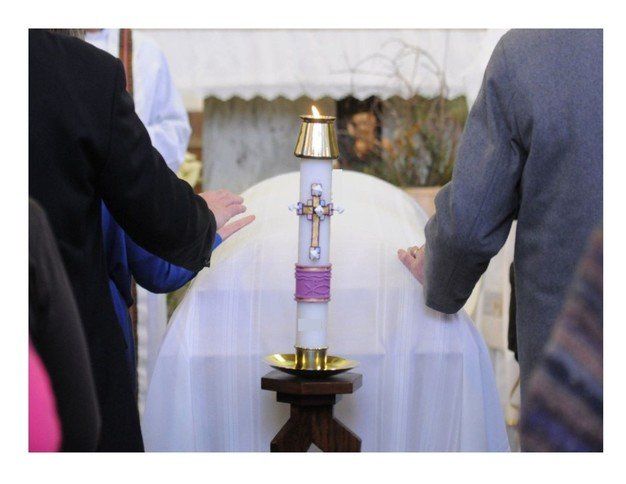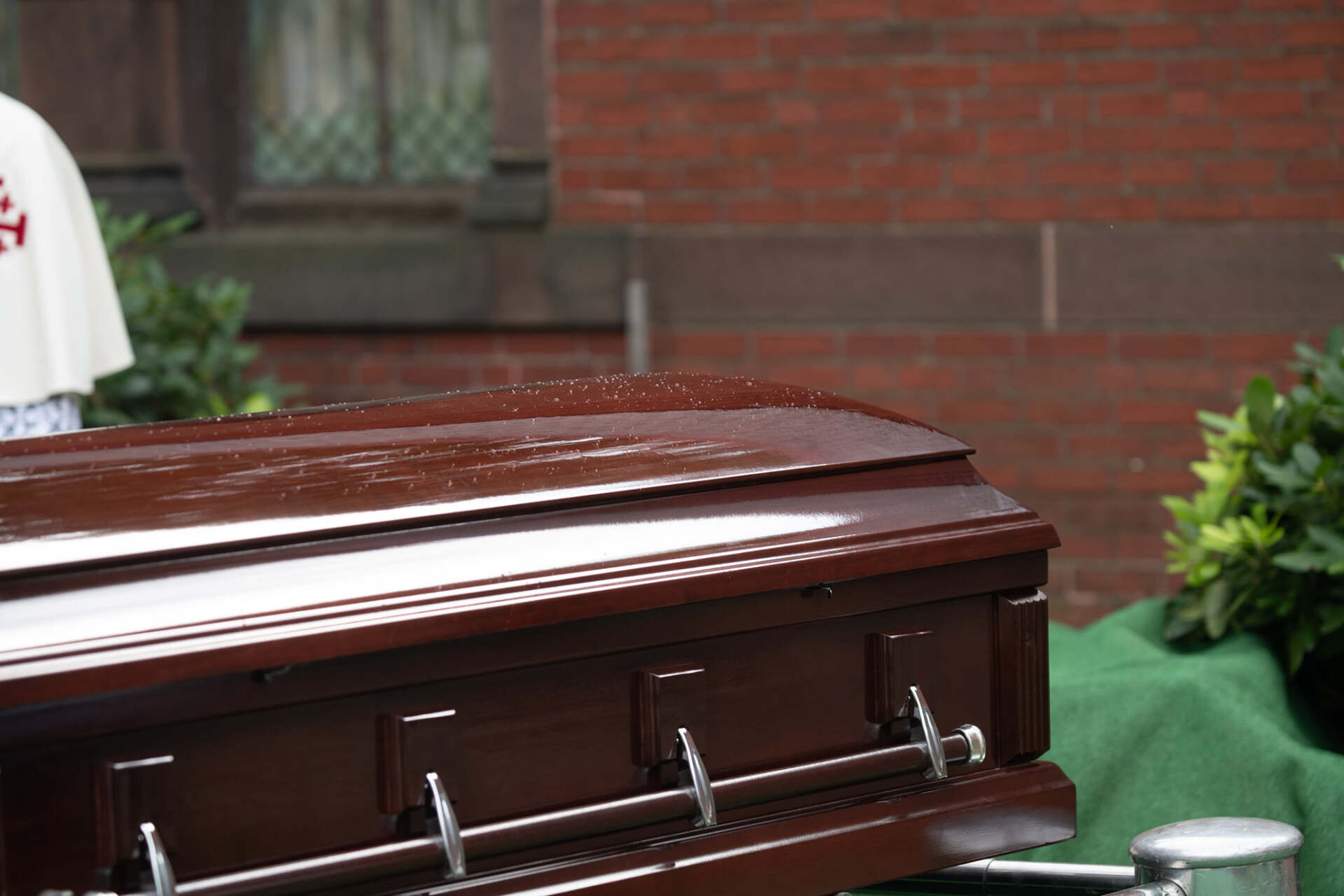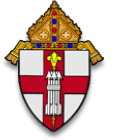Catholic Funerals
"At the death of a Christian, whose life of faith was begun in the waters of Baptism and strengthened at the Eucharistic table, the Church intercedes on behalf of the deceased because of its confident belief that death is not the end, nor does it break the bonds forged in life. The Church also ministers to the sorrowing and consoles them in the funeral rites with the comforting Word of God and the Sacrament of the Eucharist."
(Order of Christian Funerals, no. 4)
The Catholic funeral rite is divided into several stations, or parts, each with its own purpose. For this reason we recommend following the complete structure and making use of each station.
Vigil Service (Wake)
"At the vigil, the Christian community keeps watch with the family in prayer to the God of mercy and finds strength in Christ's presence" (Order of Christian Funerals, no. 56). The Vigil Service usually takes place during the period of visitation and viewing at the funeral home. It is a time to remember the life of the deceased and to commend him/her to God. In prayer we ask God to console us in our grief and give us strength to support one another.
The Vigil Service can take the form of a Service of the Word with readings from Sacred Scripture accompanied by reflection and prayers. It can also take the form of one of the prayers of the Office for the Dead from the Liturgy of the Hours. The clergy and your funeral director can assist in planning such service.
It is most appropriate, when family and friends are gathered together for visitation, to offer time for recalling the life of the deceased. For this reason, eulogies are usually encouraged to be done at the funeral home during visitation or at the Vigil Service.
Funeral Liturgy
The funeral liturgy is the central liturgical celebration of the Christian community for the deceased. When one of its members dies, the Church encourages the celebration of the funeral liturgy at a Mass. When Mass cannot be celebrated, a funeral liturgy outside Mass can be celebrated at the church or in the funeral home.
At the funeral liturgy, the Church gathers with the family and friends of the deceased to give praise and thanks to God for Christ's victory over sin and death, to commend the deceased to God's tender mercy and compassion, and to seek strength in the proclamation of the Paschal Mystery. The funeral liturgy, therefore, is an act of worship, and not merely an expression of grief.


Rite of Committal (Burial or Interment)
The Rite of Committal, the conclusion of the funeral rite, is the final act of the community of faith in caring for the body of its deceased member. It should normally be celebrated at the place of committal, that is, beside the open grave or place of interment. In committing the body to its resting place, the community expresses the hope that, with all those who have gone before us marked with the sign of faith, the deceased awaits the glory of the resurrection. The Rite of Committal is an expression of the communion that exists between the Church on earth and the Church in heaven: the deceased passes with the farewell prayers of the community of believers into the welcoming company of those who need faith no longer, but see God face-to-face
After Jesus was taken down from the cross His body was prepared, and He was placed in a grave called the Holy Sepulchre. Death as seen through the eyes of a Christian is not the end; life is changed not ended. The following are common questions and answers about what the Church says about death, Catholic funerals, cremation, and burials.
-
Christian Funeral or Celebration of Life
The (Catholic) Church through its funeral rites commends the dead to God’s merciful love and pleads for the forgiveness of their sins. At the funeral rites, especially at the celebration of the eucharistic sacrifice, the Christian community affirms and expresses the union of the Church on earth with the Church in heaven in the one great communion of saints. Though separated from the living, the dead are still at one with the community of believers on earth and benefit from their prayers and intercession. At the rite of final commendation and farewell, the community acknowledges the reality of separation and commends the deceased to God. (OCF, 6)
This short introduction to the Catholic funeral, taken from the Order of Christian Funerals, makes clear that a Catholic funeral is something very different than the “Celebration of Life” ceremonies that we see often today. These celebrations are primarily concerned with simply remembering or telling the story of the deceased and are commonly presented in a party-type atmosphere, often times after the deceased has already been cremated or buried. However, as Christians, we offer the Mass of Christian Burial to commend our loved ones to God’s merciful love, to witness to Christian hope in the resurrection and to turn always to God in times of crisis.
-
Burial or Cremation?
Although cremation is now permitted by the Church, it does not enjoy the same value as burial of the body. The Church clearly prefers and urges that the body of the deceased be present for the funeral rites, since the presence of the human body better expresses the values which the Church affirms in those rites [OCF, 413]
When the choice has been made to cremate a body, it is recommended that the cremation take place after the Funeral Liturgy. In this case, the Vigil for the Deceased and related rites and prayers, as well as the Funeral Liturgy are celebrated as they are provided in this ritual [OCF, 418].
One of the first decisions that needs to be made is whether the deceased will be buried or cremated. Cremation is allowed in the Catholic Church, so long as this option isn’t chosen to express anything contrary to Christian hope — particularly the hope in the resurrection of the body. Nonetheless, the Church’s tradition recommends burial over cremation. If cremation is chosen, whenever possible the cremation should take place only after the Christian funeral.
-
What is a Catholic Funeral?
Whereas a Celebration-of-Life is akin to a remembrance party, a Christian Funeral is a rite which commends our departed loved ones to God. It is divided into three rites:
1. Vigil (Wake) and Related Rites and Prayers:
The vigil for the deceased is the principal rite celebrated by the Christian community in the time following death and before the funeral liturgy. Words of remembrance may be spoken at this time without any limitations to the number of speakers. The vigil may be held in the home of the deceased, in the funeral home or in the church.
2. Funeral Liturgy:
The funeral Mass is the central celebration for the deceased. , the it should be scheduled for a time that permits as many of the Christian community as possible to be present. The funeral Mass can be scheduled at any time, day or evening. Funeral Masses may not be celebrated on solemnities that are Holy Days of Obligation, on Thursday of Holy Week, during the Paschal Triduum, or on the Sundays of Advent, Lent, and Easter time.
3. Rite of Committal:
The Rite of Committal at the conclusion of the funeral rites is the final act of the community of faith in caring for the body or ashes of its deceased. Whenever possible, the Rite of Committal is to be celebrated at the site of committal, that is, beside the open grave or place of interment.
-
Can Ashes be Scattered?
The cremated remains of a body should be treated with the same respect given to the human body from which they come. This includes the use of a worthy vessel to contain the ashes, the manner in which they are carried, the care and attention to appropriate placement and transport, and the final disposition. The cremated remains should be buried in a grave or entombed in a mausoleum or columbarium. The practice of scattering cremated remains on the sea, from the air, or on the ground, or keeping cremated remains in the home of a relative or friend of the deceased are not the reverent disposition that the Church requires. Whenever possible, appropriate means for recording with dignity the memory of the deceased should be adopted, such as a plaque or stone which records the name of the deceased [OCF, 417].
Scattering ashes is never permitted. The Church’s preference is that Catholics be buried in the consecrated ground of a Catholic cemetery, but other cemeteries may be chosen. The point is that bodies need to be disposed of in a fitting and dignified way, consonant with the human dignity that should be afforded to everyone, made in the image of God as we are. Cremains must also be buried intact— they are not to be placed in the home, divided among family members, used to make jewelry, spread on land or at sea, etc.
-
What takes place at a Vigil for the deceased?
Wakes, or viewings, are an opportunity for family and friends to come together, console each other and recall the impact the deceased had on them. This usually occurs at the funeral home. They find their origins in the Christian celebration of vigils, often associated with major events or feasts.
The vigil for the dead is intended to be dedicated to prayer for the deceased. The Church supplies a liturgical rite for wakes, to be celebrated by a sacred minister of the Church, or it may be celebrated by a lay minister in some cases. This is a combination of readings, a brief homily or reflection, prayers and possibly music.
The wake is also a time to celebrate any popular devotions that might have been particularly significant in the faith life of the deceased — such as the Rosary or the Divine Mercy Chaplet. Another option for the wake is to celebrate the Office of the Dead. This comes from the Liturgy of the Hours — the Church’s daily prayer, composed of psalms, readings and prayers.
Since the Catholic funeral rites do not usually envisage the opportunity for eulogies at the funeral Mass, the vigil is often a fitting time for those wishing to speak a word in memory or in honor of the deceased.
If you would like more information on planning a funeral Mass at Saint Joseph Cathedral, please complete the following and a member of our consoler's team will be in touch with you.
Contact Us
We will get back to you as soon as possible.
Please try again later.

